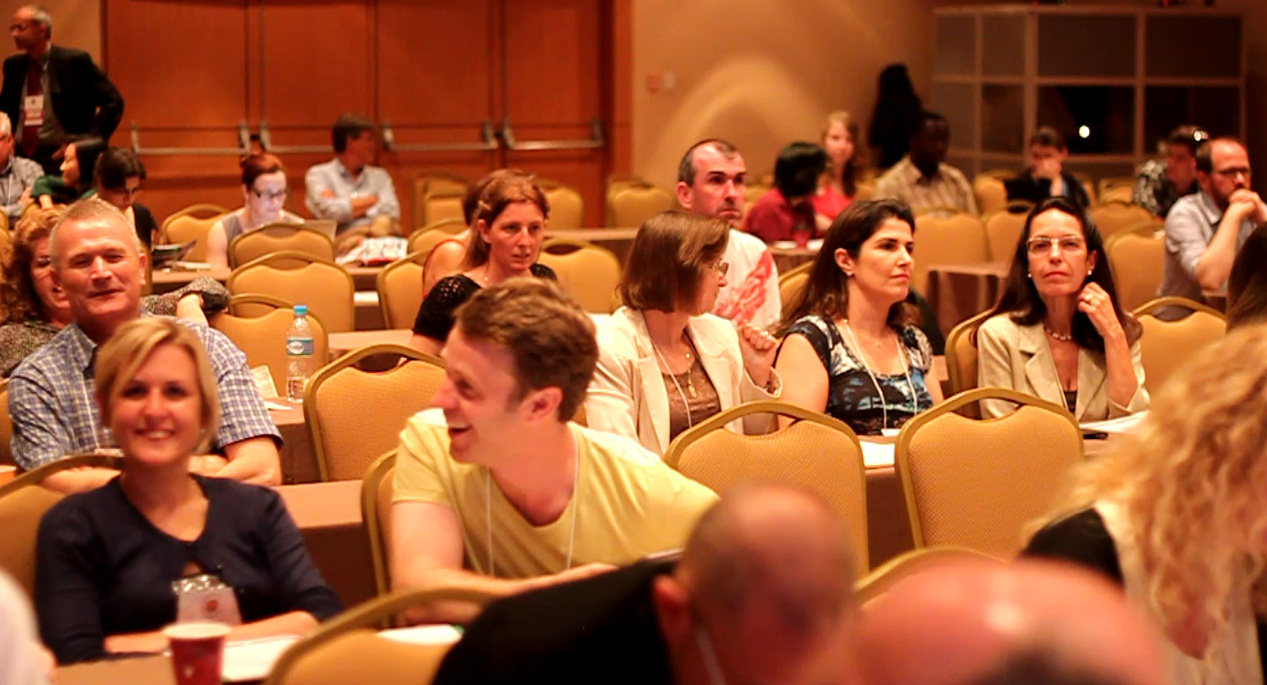
'Buzzilia' from the Huntington's Disease World Congress: day 3
#Buzzilia, day 3: Jeff and Ed's roundup of happenings from the third day of the HD World Congress in Rio de Janeiro

Our third daily report from the World Congress on Huntington’s Disease in Rio de Janeiro, Brazil.
08:05 – And we’re back, for day 3 of the World Congress on Huntington’s Disease in Rio de Janeiro
08:07 – Jim Gusella, one of the leaders of the hunt for the HD gene, addresses the WCHD on why genetics still matter in HD. Gusella is interested in the fact that the age at which people have HD symptoms varies, and some of this variation is genetic. Gusella’s group is looking for the other genetic factors which might make people have HD symptoms earlier and later.

08:11 – Gusella: Strangely, though having one mutant HD gene causes HD, having 2 copies doesn’t seem to make the disease worse. Variations in the sequence of a number of other genes have been proposed to contribute to when someone will be expected have HD. Gusella suggests that many of these proposed genetic contributors are seen in one study, but fail to be replicated in another. Gusella is now looking at the entire genome of HD patients to try and find variations associated with earlier or later onset of HD. This kind of study requires thousands of DNA samples from HD patients. Gusella believes that the variation in age of onset in HD is a cause for hope, because it suggests it’s possible to delay onset.
08:29 – Gusella: We just need to find the right genes!
08:30 – Lesley Jones addresses the WCHD about what animal ‘models’ of HD can tell us about HD. Jones notes that there are a number of changes that were seen first in animals, and only later in HD patients.
08:33 – Jones: Though mouse models of HD are genetically accurate, they have yet to help us develop a good drug for HD. Why? Many findings in mice don’t hold up when the experiment is repeated, because of inconsistencies in reporting and experiments. This is one reason why ‘breakthroughs’ in mice have so far not led to any treatments for HD. Working with mice is difficult, and there are a number of variables in handling that can change the outcome of an experiment. We are getting better at standardizing our approach to animal research in order to sort out the ‘true’ findings in HD models. Jones is part of a group working to very carefully compare different mouse models of HD.
08:42 – Jones: new genetic technologies can compare mice & humans to ask which of the many models are most similar to HD patients. Analyzing networks of genes and activities in HD model animals can reveal patterns that studying individual molecules may miss. One way to see if findings in animals are useful is to see whether human patients have genetic differences in those pathways. In order to sort out the genetic signal from the noise, we need detailed family history information.
08:51 – Laura Bannach Jardim, a Brazilian scientist studying HD, addresses the WCHD on genetic aspects of HD specific to Latin America.
08:52 – Jones: We haven’t been very good at collecting family history information so far, but it’s really important. Jardim reminds the conference how complex the background of Latin American people is, containing European, Native and African genes. Though there are almost 600 million people in Latin America, we’re not sure the exact number of people affected with HD. The high occurrence of HD in Venezuela was noted as early as the 1950’s, families there went on to contribute to finding the HD gene. Jardim notes several other locations in Peru and Brazil have high occurrence of HD.
09:16 – Anita Goh studies genetic discrimination against HD patients and families at the University of Melbourne
09:19 – Goh: we live in an age when people can get a lot of genetic information about themselves, often without help understanding it. Companies like 23AndMe give consumers a lot of genetic information, without help understanding its implications. ‘Genetic discrimination’ is differential treatment or denial of rights based on genetic information. Goh has studied genetic discrimination in HD mutation carriers in Australia, as part of the PREDICT-HD study. About a third of HD mutation carriers responding to Goh’s survey reported experiencing genetic discrimination. Many people surveyed by Goh experienced problems acquiring life insurance after their genetic test. Goh has started a website to help Australian HD families deal with genetic discrimination called ‘Genetic Discrimination: Know your rights’.
09:48 – Katharina Kubera summarizes a number of brain scan studies, which show early changes in the way HD mutation carrier brains work. These changes seem to precede any changes in brain shape, which means that HD brains might be compensating for HD for decades. The idea of “compensation” has been a theme of the WCHD. Brains actually seem pretty good at dealing with HD damage for a long time.
“Gusella is now looking at the entire genome of HD patients to try and find variations associated with earlier or later onset of HD. This kind of study requires thousands of DNA samples from HD patients.”
09:57 – Michael Orth studies the psychological changes associated with HD. rth notes that brain scans show early shrinkage in HD muation carriers, but people’s mental performance stays normal for a long time. Orth uses a really cool technique called “transcranial magnetic stimulation” to study brain function in HD. TMS allows Orth to de-activate parts of the brain temporarily. Watching the brain wake up is a unique way to study HD brain function.
10:16 – Tiago Mestre, from Toronto, is interested in changes in HD patients in the fluid that surrounds the brain – the ‘cerebrospinal fluid’. Though CSF is collected from the spine, it directly bathes the brain and so is a good place to look for early changes in HD. Mestre’s goal is to look for differences in HD patient CSF, in hopes that these changes might be corrected in a drug trial. Mestre suggests that in Alzheimer’s Disease, there are very specific changes observed in the CSF. We’re not there yet in HD. Luckily, we can learn lessons from the experience of other diseases, like Alzheimer’s Disease.
10:35 – Christina Sampaio is the chief clinical officer of the CHDI foundation, working on developing and testing new treatments for HD. Sampaio is interested in “biomarkers” in HD. CHDI has a team working on developing biomarkers for HD.
13:24 – In the ‘families’ session, Ignacio Munoz-Sanjuan is talking about ‘Factor_H’. FactorH aims to improve the quality of life for people impacted by Huntington’s disease in Latin America. FactorH is a non-profit and is not affiliated with any existing scientific or other institution
13:27 – Munoz-Sanjuan: FactorH aims to carry out specific projects, liaise with NGOs, increase awareness and mobilize local communities. FactorH is working with Habitat for Humanity to direct much needed aid to Latin American families affected by HD.
14:15 – The next session is an important one – on genetic testing for HD and the current around ‘predictive’ testing. Predictive testing is where someone at risk of HD has a genetic test to tell them whether they have the mutation that causes HD. If the mutation is present, it means that person will get HD symptoms at some point in the future. Deciding whether to test is a difficult one and a personal decision with no right or wrong answer. Expert genetic counseling is essential to help ensure a person is fully informed and has had enough time to think things through. Internationally agreed guidelines exist to ensure that genetic counseling is reliable, detailed and expertly offered.
14:20 – Rhona Macleod updates us on the current guidelines.
14:22 – Macleod: A confusing area is the gray area between a clearly positive & clearly negative test. Results in the gray area are rare and recent research may help us to understand them. Predictive testing of children isn’t done because it takes away their right to choose for themselves. This is controversial! The guidelines, written in 1994, might need updating in the light of experience & new scientific evidence. The World Federation for Neurology and International Huntington Association are reviewing the guidelines. No changes are set in stone and any updates will need to be approved by the HD community.
14:42 – Representing the IHA, Asun Martinez suggests that the guidelines need to be reviewed and better monitored to ensure they’re followed.
14:48 – Claudia Perandones (Argentina) notes that in much of Latin America, genetic testing is unavailable or done without proper counseling.

14:56 – We hear from a Brazilian family member that 40 members of a family were tested by a private lab and all the results sent to one person. It was disastrous – this is the kind of thing the guidelines are designed to prevent.
15:19 – Helpful discussion with experts & family members. Seems to be general appetite for revising the guidelines & ensuring they’re followed
16:27 – Today’s final session is about the ENROLL-HD study.
16:28 – ENROLL-HD is a global observational study of HD that aims to enroll as many people as possible. ENROLL aims to help us understand HD, and also to speed recruitment for forthcoming clinical trials to help drugs get tested quickly. ENROLL will enable qualified HD researchers to securely access information about HD mutation carriers, hopefully accelerating research
16:32 – Monica Haddad, a Brazilian neurologist, discusses how sharing information about patients can inform better care for HD patients. Haddad notes that quality of care for HD patients varies widely from country to country. Haddad hopes that what is learned in ENROLL will inform doctors around the world about better methods of care for HD
16:42 – Claudia Perandones, an Argentinian physician studying HD, describes ‘clusters’ of HD patients throughout Latin America. Large HD families in Latin America have already taught us much about HD genetics, Perandones suggests we can still learn more.
Sunset conclusions
Today the congress heard from both familiar international HD researchers, as well as a large number of voices from the host scientists of Latin America. We were reminded by researchers studying human HD how critical the involvement of family members is to scientific research. The results of genetic studies were shown that involve over 3,000 HD patient volunteers, as well as many results from TRACK-HD, which involved the intensive study of 300 volunteers over 3 years. Family members and lay organizations remain engaged and passionate, as we saw in the afternoon discussion about predictive testing guidelines. It’s clear that we have a way to go to develop HD treatments, but the active engagement of the entire global HD community is a key part of our success this far.
Learn more
For more information about our disclosure policy see our FAQ…


